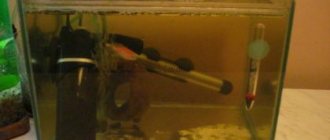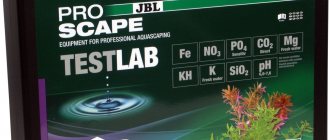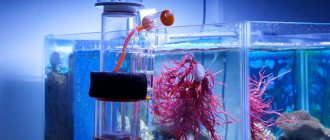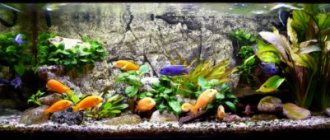What kind of water to fill
It is necessary to create the most comfortable microclimate for the inhabitants and plants in the aquarium. Water must meet certain parameters. It should be soft and have a neutral ph.
If you live in a large city, then this is what the tap water will be, but it also needs to be properly prepared.
Nobody can answer you whether it is possible to put bottled water in an aquarium or not. Aquarists have been arguing about this for a long time and everyone defends their point of view.
If you decide to use this particular option, be sure to check the liquid for all possible indicators. Manufacturers follow GOST; the content of some substances according to it exceeds the norms for the composition of aquarium water.
How long to settle water for an aquarium
Tap water is purified using ozone and chlorine gases. They can be seen with the naked eye. They appear in the form of bubbles on the walls of the vessel. To get rid of them, as well as various solid impurities, the aquarium water needs to be settled.
It should be poured into a bottle or basin. The surface area of the water should be as large as possible; it is from it that gases evaporate. The container must not be closed.
Solid impurities contained in the city water supply will settle to the bottom of the container in a few hours, and gaseous impurities will evaporate in about a day. Exactly this amount of time needs to be left in soft water with a neutral pH.
When pouring liquid into an aquarium, do not shake the container so that the sediment does not dissolve again in the water. You can make your task easier by installing a filtration system. It will retain not only solid impurities, but also liquid ones that do not disappear from the water when settled.
What are pH and hardness?
pH is the pH value of an acidic environment. A pH of 7 is considered neutral, as it is more favorable for most aquarium inhabitants. When it is less than 7, the water is alkaline. In order to easily determine the pH of water, you need to purchase litmus papers with a color chart, or specialized aquarium tests.
The second parameter of water is hardness. It is divided into temporary and permanent. Water hardness can also affect aquarium inhabitants. To avoid unpleasant consequences, aquarium water should also be checked for permanent and temporary hardness. It is measured in degrees and calculated by adding temporary and permanent hardness.
In cases where spawning of a certain type of fish is necessary, for example, such as neons, whose eggs can only survive in very soft water, water with a low hardness content is used. However, for most varieties of aquarium fish, water with a hardness content of less than 5 is not suitable for life and reproduction. At the same time, too high water hardness, such as 25 degrees and above, is also detrimental to most aquarium species. Of course, there are exceptions.
The norm is considered to be a hardness of 5 to 25 degrees, which is favorable for the vast majority of different types of aquarium fish.
Aquarists who don't want to bother with different measurements can simply select certain species of fish that thrive in regular tap water.
INVENTORY REQUIRED FOR AQUARIUM.
AERATION IN THE AQUARIUM AND EVERYTHING YOU NEED TO KNOW ABOUT IT.
SPRAYER FOR AQUARIUM AND EVERYTHING YOU NEED TO KNOW ABOUT IT.
Mitigation
In small towns and private houses with artesian wells and wells, everything is a little more complicated. The tap is most likely leaking hard water. This is due to the increased content of calcium and various salts in it.
There are several signs by which you can determine hard water without laboratory testing:
- after washing in hard water, fabrics become hard and white streaks appear on things;
- lime deposits regularly appear on the walls of the kettle (scale);
- plaque appears on chrome faucets;
- After washing with hard water, facial skin feels tight and dry;
- Detergents and washing powders do not foam well.
This water can only be used for an aquarium with viviparous fish. They are more resistant to negative environments.
But keep in mind that in hard water the fry will die within a few hours, and some aquarium plants may not develop well.
There are many methods for softening water that can be used in combination or separately.
Here's how to prepare water for an aquarium:
- Plant elodea and hornwort in the aquarium. During their life activity, these plants reduce the concentration of salts, magnesium and calcium, which significantly softens the water and improves the microclimate of the aquarium.
- Dilute hard water with soft water in a ratio of 1:2. Distilled water is suitable for this. You can buy it at a pharmacy or pet store.
- You can purchase a special reverse osmosis membrane for an aquarium at a pet store. This modern device effectively purifies water from impurities.
- A special softener based on ion exchange resins has the same effect. It is suitable for aquariums of any size. Resins soften hard water, but over time they must be replaced with new ones, following the instructions.
- An emergency solution for moderately hard water is boiling. The degree of mitigation is small. When boiling, all useful substances disappear from water, which is why you cannot fill aquariums with chilled boiled water.
- Modern chemicals cope well with this problem. You can buy them at any pet store. They not only soften the water, but also preserve the mineral content in it, thereby helping to maintain a favorable environment for fish and plants.
- Water can be frozen. To do this, pour it into a bottle and place it in the freezer; when it is half frozen, drain the liquid part, melt the ice and use it for the aquarium.
- Install water filters in your home. They soften the water well; all you have to do is let it sit for a day to clear it of gaseous impurities.
Filling an aquarium with distillate only is possible only as a last resort. It lacks both harmful and beneficial substances necessary for fish and vegetation. Hard water can be diluted with rainwater. It should be well strained to remove natural debris. In winter, melted snow should be used.
You should not soften water by eye. Buy a special device for measuring water hardness or test strips at a pet store.
The water hardness level for most aquariums should be maintained at a level of 3–15° hD. Do not confuse hardness with acidity (ph).
If necessary, you can increase the hardness by placing shells in the aquarium or adding baking soda. One teaspoon of soda dissolved in 50 liters of water will increase hardness by 4°dKH.
Step-by-step instructions for preparing at home
Each type of water has its own optimal indicators.
Type H2O
What kind of water should be poured into the aquarium?
Tap
Can only be used after standing for a while.
Pros:
- budget and convenient option;
- microorganisms live in it.
Minuses:
- increased rigidity;
- The possibility of pathogenic bacteria entering cannot be ruled out.
Boiled
Suitable only for those fish that have lived in boiled water since birth.
Pros: absence of harmful microorganisms and bacteria.
- when boiling, not only harmful, but also beneficial microbodies are killed;
- for large aquariums you will need to boil the water several times;
- hardness is below normal.
Filtered
It is considered “dead” water and is strikingly different from the natural habitat of fish.
Also needs defending.
- Pros: absence of harmful metals and impurities.
- Cons: lack of useful microelements.
Bottled
Not suitable for all types of fish, may be dangerous for shellfish.
Pros:
- no chlorine;
- does not require settling.
Minuses:
- non-compliance with the required level of rigidity;
- high price.
Distilled
It is not used to fill an aquarium in its pure form, since it is absolutely sterile and does not have the necessary connections. Suitable for diluting too hard water.
Rainy
Similar to distilled in the complete absence of microelements. Suitable for reducing hardness, but after preliminary analysis, because may contain harmful acids that kill fish.
From natural sources
Such water may be dangerous for domesticated fish. Therefore, before filling the aquarium from the nearest river, you should do a water analysis.
Advocacy
How to properly defend tap water:
time - at least 2 days;- a suitable container is glass, clean, and does not contain chemicals (an ordinary jar will do);
- lid - the container cannot be closed so as not to change the oxygen level; it is enough to cover it with gauze to avoid the ingress of dust or dirt.
Some breeders prefer to settle the water directly in the aquarium. This option is not entirely advisable due to possible sediment. However, to clean a new tank, it should be filled with water for a few days and then drained. Fish should not be released into such an environment.
After this, settled water is collected into a new, cleaned aquarium, which should stand for another week. Only now does the environment become suitable for fish to live in.
H2O level
The water level depends on:
the presence of floating plants - if the water level is too high, they can get burned due to the lighting lamp, the distance should be at least 8 cm;- the presence of algae growing on the surface - they need a sufficient amount of air;
- the presence of snails - if the water level is too high, mollusks can crawl out of the aquarium;
- high levels may reduce lamp efficiency;
- if there are special fans in the summer, water evaporates faster, so the level should be slightly higher than usual;
- If you have heaters and filters, you need to make sure that the level does not drop too much, otherwise the devices may break.
The level also depends on the type of fish:
- ancistrus - two or three individuals can live in an 80-liter tank;
- guppy – suitable for any size aquarium with a high water level;
- marbled gourami – at least 80 liters;
- goldfish - a wide aquarium of at least 80 liters per individual;
- lalius – 10 liters per fish;
- macropod - a 20-liter tank for one individual, be sure to cover it with a lid;
- Velifera molly – a tank of at least 50 liters;
- neon – medium-sized aquarium;
- betta is a tank of different sizes, depending on the total number of fish.
Partial replacement
Partial replacement of water in a closed aquarium system emulates natural conditions. In any body of water there is a natural circulation of water. Some of the moisture evaporates or is absorbed into the ground, and is replaced by water from springs and tributaries.
Nitrates, toxins and harmful substances accumulate in the aquarium, which appear during the life of its inhabitants, and the more there are, the more often it is worth replacing part of the water with new one.
Only ¼ of the total water needs to be replaced. In this case, the balance will be restored within a few days, and plants and the most sensitive inhabitants will not be harmed. You need to replace the water in a saltwater aquarium in the same way, but use special salt.
When replacing half the volume of liquid, many inhabitants of the aquarium may die; restoration of the ecosystem will take several weeks.
Gaseous parameters of water space
Gases escape through the water surface. Here we should consider both the qualitative and quantitative composition of dissolved gases in the water space. Gases in the natural environment react with elements in chemicals. reactions due to diffusion regularly circulate through the water space and are not dangerous to the inhabitants.
The method of water disinfection for your area can be found out at the water utility - this information will not be superfluous. At older water treatment stations, purification using ozone and ultraviolet is used. You can easily add it to such a liquid without any danger; there is absolutely no point in protecting it from oxygen and photons.
The old method of cleaning with chlorine will eventually become a thing of the past, but it is still used. Chlorine, as well as all its derivatives, are poisons. All of them help to remove harmful and beneficial bacteria, also depending on the population of large inhabitants.
Frequency
When it comes to the frequency of fluid replacement, it is worth starting from the number of inhabitants and the age of the entire system as a whole. The stage of formation of the ecosystem of a new aquarium should not be interfered with for at least 2.5–3 months.
After this time, the balance will be fully formed. A 20% water change should be done approximately once a month. At the same time, do not forget to clean the soil and walls of the aquarium from the inside.
After approximately 6 months, the aquatic system is considered mature. The water should be changed at the same frequency. There is no point in once again interfering with the stable way of life of the inhabitants.
A year and a half after moving in, the aquarium is considered old. To update it, experts advise changing the water every two weeks for two months.
You should carefully remove and wash the soil. There will be a kind of update of the entire system as a whole. After which you need to return to the usual water replacement schedule for another 2 years.
How can I speed up the process?
Since settling is a lengthy procedure, you can purify water much faster using specialized conditioners.
Reference! This specialized product is absolutely harmless, but it should be used only in accordance with the instructions, otherwise the fish may die.
Pros of air conditioners:
- chlorine removal;
- antibacterial effect;
- normalization of water transparency;
- protection against fungi and snails;
- normalization of pH and KH.
Almost all conditioners are used according to the classical scheme - 5 ml of product per 50 liters of water.
If the drug gets on the skin or mucous membranes, rinse immediately with clean water.
Temperature
The main indicator on which the health of fish, shellfish and plants depends is water temperature.
It must be maintained at a certain level, avoiding sudden changes. Please note that different inhabitants require their own temperature regime.
For most popular fish species, a temperature of 22 to 26 °C is suitable.
The exceptions are:
- Labyrinth fish and dixus. They prefer warmer water, with a temperature of 28 – 31 °C.
- Goldfish. They need cooler water from 18 – 23 °C. At standard temperatures they often get sick and rarely live more than a year.
Acquire in advance the entire arsenal of devices for measuring and adjusting water. A thermometer and thermostat are the basic items needed. Do not allow the temperature to rise more than 3 °C. This will lead to stress or illness in the fish and death of the plants.
Problems
There are some problems that aquarists encounter most often. They all have their own reasons and solutions.
Why does the water in the aquarium become cloudy?
Causes and solutions to the problem:
- If you just got an aquarium, then the cause of cloudy water may well be bacteria. Their active reproduction will end in 5–7 days and the water will become clear. Until this moment, you should not put fish there. Don't change the fluid! The process of bacterial reproduction will begin again;
- the water becomes cloudy and spoils when there is an excess of food. It settles on the ground and deteriorates, promoting cloudiness and the proliferation of pathogenic bacteria. Reduce the amount of food or introduce bottom-dwelling fish that will eat excess food;
- poor water filtration. Check the serviceability of the filter and its suitability for the volume of the aquarium;
- Poorly washed soil also causes turbidity. It should be thoroughly rinsed under running water until it becomes clear;
- new decorations in the aquarium, especially those made of wood, contribute to an outbreak of bacterial growth. The problem will disappear on its own in about 7 days.
When choosing a device, consider the number of “inhabitants of the reservoir”. If the cause of cloudy water is filtration, then it must be eliminated as quickly as possible! Waste products poison the water and the fish may die.
Aeration
Aeration is responsible for the amount of dissolved oxygen and is controlled by:
- Plants. Plants produce oxygen through the process of photosynthesis. In the dark, plants absorb oxygen, releasing carbon dioxide.
- Temperature. At elevated temperatures, oxygen spreads less efficiently.
- The population of the aquarium. In overcrowded conditions, inhabitants need more oxygen.
- Equipment. The aquarist is provided with compressors, aquarium pumps, and an aquarium filter with additional aeration. Give preference to devices that are solely responsible for aeration.
If the fish do not have enough air, they breathe heavily and prefer the upper layers.
Green water
Causes:
- Too much light. This provokes the reproduction and growth of euglena, which, when in excess, turns the water green.
- Poor filtration with a large number of inhabitants contributes to pollution by fish waste and algal blooms.
- Excess feed.
Solution to the problem:
- You should not change the water in the aquarium. This is harmful to the inhabitants and will provoke even more active proliferation of algae. It’s better to get little “orderlies” that eat algae. These include snails, catfish and daphnia.
- Move the aquarium away from windows. Replace natural light with artificial light and follow the lighting mode.
- You can purchase special products at the pet store to combat this problem.
- Check the filters and reduce the amount of feed.
Film on the surface
Causes:
- Poor water circulation leads to stagnation and causes film formation. Create an artificial surface flow using special filter attachments.
- A bacterial film occurs when there is an excess of organic waste from fish and plants. Reduce the amount of feed and check that the filter is working properly.
- Increased fat content of feed. Fat forms a film on water and is a favorable environment for the proliferation of saprophytic bacteria. Replace organic and flake food with kibble.
- Algae can form a film in the aquarium. Get snails, sharks and viviparous fish; they readily eat algae from the walls of the aquarium and the surface of the water.
- A film with rainbow stains appears if any aquarium decoration is made of low-quality materials. Remove such decor from the water immediately!
There is another way to make the water in an aquarium crystal clear. If the filter design allows, then place activated carbon in it. He will remove the film within 24 hours, regardless of the reasons for its appearance.
Preventing any problem is always easier than eliminating it. Think through all the nuances of keeping fish in advance, change the water on time and monitor the state of the ecosystem in the aquarium, then your pets will not cause you trouble and will delight you for a long time.
Other interesting articles
- Large, medium and small peaceful fish for the aquarium Among various types of pets, aquarium fish are especially popular. They are relatively inexpensive, not...
- How to keep your aquarium water clean without a filter When planning to buy an aquarium, beginners like to ask themselves this question. The reason is banal: reluctance to spend money on purchasing...
- The swordtail lies on the bottom of the aquarium and breathes frequently. What to do if the fish behaves unusually, try to observe it as carefully as possible and...











